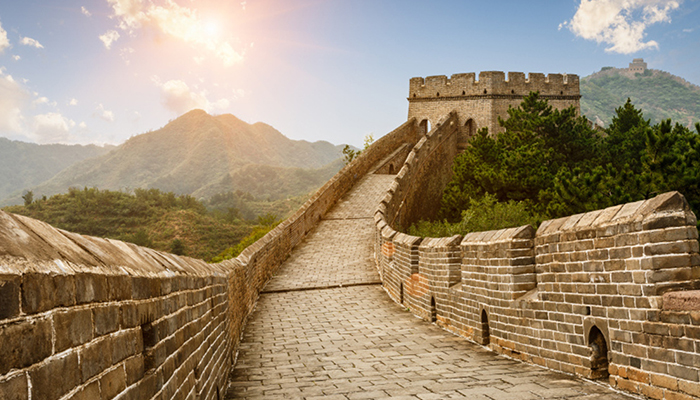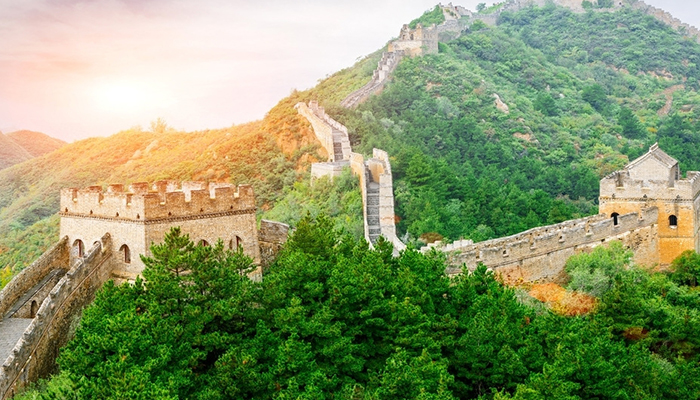The Great Wall
The Great Wall, also known as the Great Wall, is an ancient Chinese military defense project, is a tall, strong and continuous placanticline to limit the movement of the enemy riders. The Great Wall is not a single isolated wall, but a defense system with the city wall as the main body, combined with a large number of cities, barriers, pavilions and signs.

The history of the construction of the Great Wall can be traced back to the Western Zhou Dynasty, where the famous allusion "the princes of beacon fire opera" occurred in the capital of Haojing (now Xi'an, Shaanxi Province). During the Spring and Autumn Period and the Warring States Period, the nations fought for hegemony and defended each other. The construction of the Great Wall reached its first climax, but the length of the building was relatively short. After the unification of the six kingdoms, the first emperor of Qin connected and repaired the the Great Wall of the Warring States period. The Ming Dynasty was the last dynasty to overhaul the Great Wall. The the Great Wall that people see today is mostly built at this time.

Great Wall resources are mainly distributed in Hebei, Beijing, Tianjin, Shanxi, Shaanxi, Gansu, Inner Mongolia, Heilongjiang, Jilin, Liaoning, Shandong, Henan, Qinghai, Ningxia, Xinjiang and other 15 provinces and cities. Shaanxi is the most abundant province in China's the Great Wall. The the Great Wall is 1838 kilometers long. According to the national survey of the Great Wall resources conducted by the Department of cultural relics and surveying and mapping, the total length of the Great Wall of the Ming Dynasty was 8 851.8 km, the Qin and Han Dynasties and the early Great Wall exceeded 10,000 km and the total length exceeded 21,000 km.

In March 4, 1961, the Great Wall was declared the first batch of national key cultural relics protection units by the State Council. In December 1987, the Great Wall was listed as a world cultural heritage.


-
1.Dongpos braised pork
Dongpo meat, also known as roll meat and Dongpo stewed pork, is a famous traditional dish in Meishan and Jiangnan area
Time 2018-10-27 -
2.Chinese Elk Garden Scenic Spot
Jiangsu Dafeng Elk National Nature Reserve is located in the Yellow Sea coast, with a total area of 78,000 hectares, including 2668 hectares in the core area
Time 2018-12-06 -
3.Yuelu Mountain and Orange Prefecture Tourist Area
Orange Island Scenic Area is located in the heart of the Xiangjiang River opposite Changsha City, Hunan Province. It is the largest famous island in the Xiangjiang River with an area of 91.4 hectares
Time 2018-12-12 -
4.Qinhu National Wetland Park
Qinhu National Wetland Park is located between the central part of Jiangsu Province and the Yangtze and Huaihe River. The total area of the scenic spot is 26 square kilometers.
Time 2019-02-07 -
5.Hui Heavy Knife Wushu
Heavy knife is the original name of big knife. It is a traditional weapon around Beijing and Tianjin. It has a history of thousands of years in China. The original name of Jinmen
Time 2019-05-04 -
6.Cutting Skill of Kaner Well
Kanerjing is the meaning of "well hole". It has been recorded as early as in Historical Records. It is called "well canal", while Xinjiang Uygur language is called "Kanerzi&qu
Time 2019-05-08 -
7.Production Techniques of National Musical Instruments
The production of national musical instruments in Suzhou is one of the local traditional handicraft techniques in Jiangsu Province. With a long history, a wide range of varieties, exquisite skills and
Time 2019-06-05 -
8.Pingxiang spring Gong
Pingxiang Spring Gong is a traditional form of music evolved from Primula in Pingxiang, Jiangxi Province. It is widely spread in Pingxiang City and its surrounding areas. It uses Pingxiang dialect and
Time 2019-06-09 -
9.Pudong Storytelling
Pudong storytelling, also known as cymbal books, Shanghai books, peasant books and so on. Pudong pays equal attention to both storytelling and singing, pays attention to plot, and has a fast rhythm. T
Time 2019-06-09 -
10.Beijing University of Civil Engineering and Architecture
Beijing Architectural University is a pilot University jointly constructed by Beijing and the Ministry of Housing and Urban-Rural Construction, the "Education and Training Plan for Excellent Engi
Time 2019-09-06 -
11.Nanchong Education
By the end of 2019, there were 271 primary schools in Nanchong, with 57000 students enrolled and 356700 students in school. The enrollment rate of primary school-age children was 100%. There are 427 junior high schools with 62900 students and 185300 students in school.
Time 2020-12-17 -
12.Meishan Sports
In 2019, 45 games will be held and 30000 people will participate in the games. At the end of the year, there were 116 sports associations. By the end of the year, there were 1410 sports venues in the education system. Meishan post and telecommunication
Time 2020-12-18